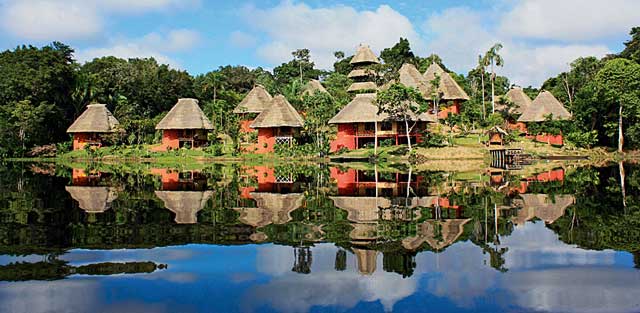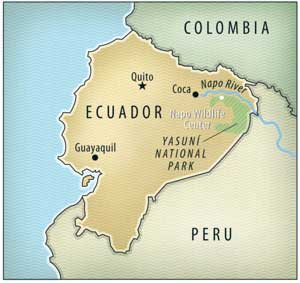sierraclub.org - sierra magazine - sept/oct 2012 - escape: napo wildlife center, ecuador

Courtesy of Napo Wildlife Center
Napo Wildlife Center, Ecuador
WHERE
Yasuni National Park, Ecuador
HOW MUCH
$820 for three nights, including all meals
MORE
napowildlifecenter.com
GETTING THERE Touch down in Quito, Ecuador's high-mountain capital, and enjoy a breath of thin air--something to reminisce about in the coming days of 80 percent riverside humidity. From there, it's a half-hour flight east to the town of Coca, a rough-and-tumble gateway to Yasuni National Park and the country's rainforest. After a cushy, two-hour-plus motorboat ride on the Napo River, ready your binoculars for the final stretch: a guided canoe ride up a side creek busy with howler monkeys and giant otters. Both species live up to their adjectives.
BEST MOMENT Nighttime paddling around the lagoon adjacent to the Napo Wildlife Center's lodge. Lily pads covered in glowworms shine like distant cities.
WORST MOMENT Being summoned to dance with a bored Anangu Kichwa woman during an excruciatingly awkward indigenous-culture presentation. The education session had its moments, but the vaguely imperialist natives-dancing-with-the-gringos shtick just seemed to make both sides uncomfortable.
FAVORITE CHARACTER Veteran rainforest guide and biologist Oscar Delgado, who can explain why parrots nibble on exposed clay ledges (for their digestion) and which tree has sap that's used to treat eczema (the dragon's blood). Buy him a beer, and he'll also tell you which beach towns have the prettiest chicas and why Ecuador's ceviche is better than Peru's.
 Map by Peter and Maria Hoey
Map by Peter and Maria Hoey
LOCAL LORE Jaguars are the kings of the Ecuadoran jungle, and while they're rarely seen, every person along the Napo seems to have a jaguar-spotting tale. Then again, some South American myths hold that jaguars have shape-shifting abilities, so maybe you're seeing them all the time and just don't know it.
WHAT'S GREEN The local Anangu Kichwa community owns and runs the lodge, and every dollar sustains its stewardship efforts and low-impact way of life. Tourism also provides a lucrative alternative to oil extraction, the region's economic mainstay since the 1970s, and farming, which would require clearcutting.
WHAT'S NOT GREEN Napo gets props for its four-stroke engines, but unless you're a strong swimmer and unafraid of caimans (South American crocodilians), you'll still be traveling about 50 river miles each way using some pretty hefty outboard motors.
PLANET SAVING OPPORTUNITIES
Yasuni's 2.4 million acres contain 20 percent of Ecuador's oil reserves. Pockets have already been drilled for oil, and there's pressure to exploit a 500,000-acre tract east of the lodge as well. In 2007, Ecuador floated a unique proposal to other countries around the world: Reimburse us for half of the lost income and we'll keep the oil companies out, plus earmark the money for alternative-energy and reforestation projects. With $3.6 billion to raise over 12 years, the heavy lifting is up to governments, but the U.N.-managed trust fund accepts individual donations at mdtf.undp.org/yasuni. --Brian Kevin